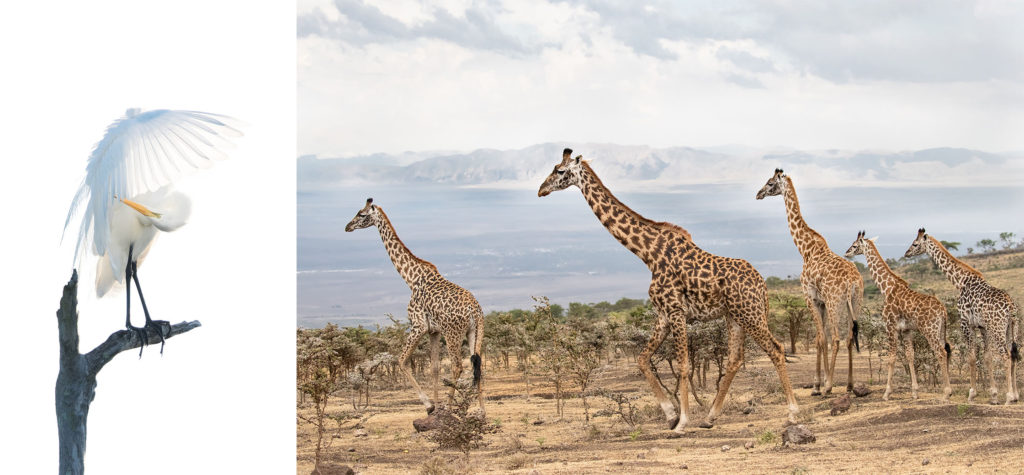I am honored to have two pieces currently on display at the Artisan Gallery in Binghamton, NY. Throughout the month of July, “Katrina’s Light” and “Masai Giraffes of Tarangire” have joined a number of beautiful artworks in the annual Broome County Arts Council (BCAC) artist’s juried exhibition.
– “Katrina’s Light” is a 16″ x 24″ print, framed with custom matting at 20″ x 30″
– “Masai Giraffes of Tarangire” is a 30″ x 30″ canvas wrap
Both subjects that I have included in this show have been or currently are, endangered. I recently had the opportunity to give a talk about my work and these pieces in downtown Binghamton. The following is an excerpt from that talk introducing the subjects of these two prints as well as the pieces themselves.
Katrina’s Light and the Recovery of the great Egret
During breeding season, already beautiful egrets grow feather plumes or aigrettes. In the late 19th century, feathered hats featuring these seasonal plumes became trendy and very popular. To acquire the feathers, the birds would be killed. As the popularity of this fashion statement grew, egret populations plumetted, dropping by more than 95%. Conservationists stepped forward and legislation was introduced and plume hunting banned. This allowed the species to recover to a much more sustainable level.
These days egrets are very common and often over-photographed to the point of being prosaic. That’s what entered my head when I saw this bird perched on a high snag one morning in Florida. The sky was a haze of white and the bird almost black against the bright sun. Even silhouettes would have been uninteresting.
A conversation I’d had with my boyfriend’s daughter-in-law Katrina popped into my head. A portrait photographer, she loves to place her subjects in shadow with the sun behind them. She then exposes high key to pull out details and create a soft glow. I thought, “I can do that with birds!” I set up my tripod and positioned it to place the sun at a 45 degree angle behind the egret. I watched for several minutes, waiting for interesting behavior. All birds preen frequently. They have a gland near the base of their tail which secretes oil. With their beaks they tap into this oil and spread it on their feathers to protect them from the environment. I waited for this egret to preen. When it lifted its wing, I saw that the feathers became almost transluscent. I fired away and this was my favorite frame. Katrina’s Light.
Masai Giraffes of Tarangire
Unfortunately, Masai Giraffes don’t currently have a happy success story as do wading birds in the US. The tallest land mammals, there is little to rival the sight of giraffes lumbering through the African savannah. Also known as Kilamanjaro giraffes, they are the tallest subspecies of giraffes and distinguishable by their jagged spots. Due to a dramatic decline in population, as of July 2019, these giraffes have been classified as endangered. Once found throughout Africa, loss of habitat, deforestation and poaching have reduced their range to only small subdivisions of a handful of African countries. I’m glad I was able to experience and capture this moment. If this trend continues, one day our images will be all that remains.
As illustrated by the successful recovery egrets and many other species in the United States, conservation measures can be hugely successful. Learn more about how organizations are protecting the world’s wildlife at the links below.
And stop by the Artisan gallery through July to see these works! The gallery is located at 95 Court Street, Binghamton, See more details at their website.


I almost forgot to comment on this. Oops! Thanks for posting the excerpt from your talk. Wish I could be there to see your work on display! These are beautiful images, and I love hearing those accompanying stories as well. Well done, Teri!